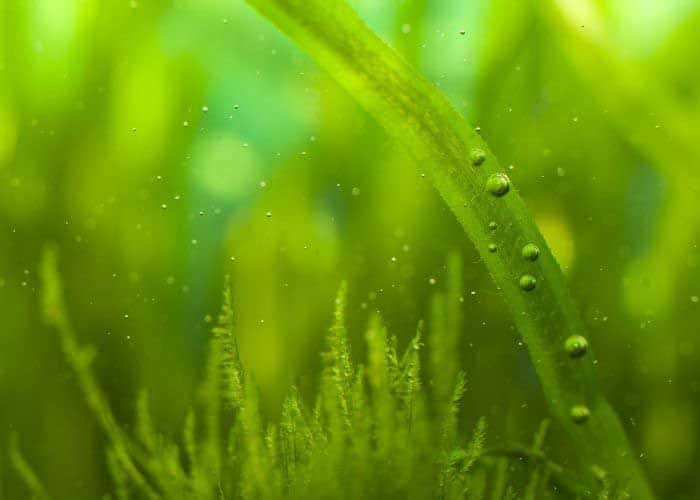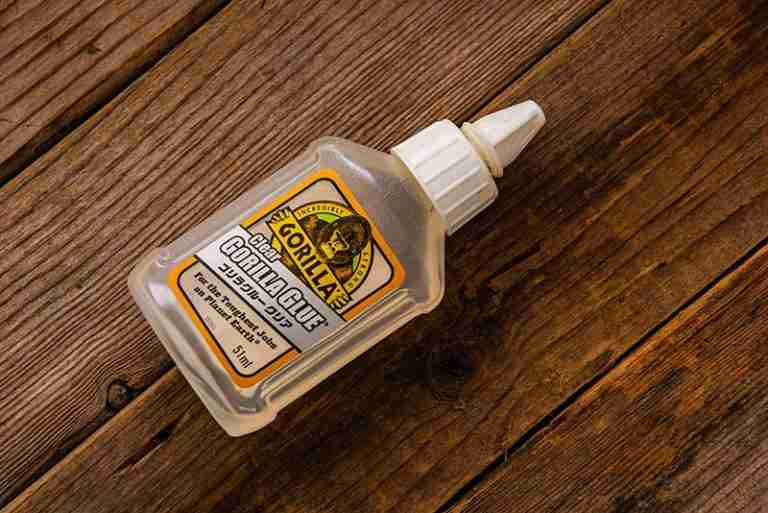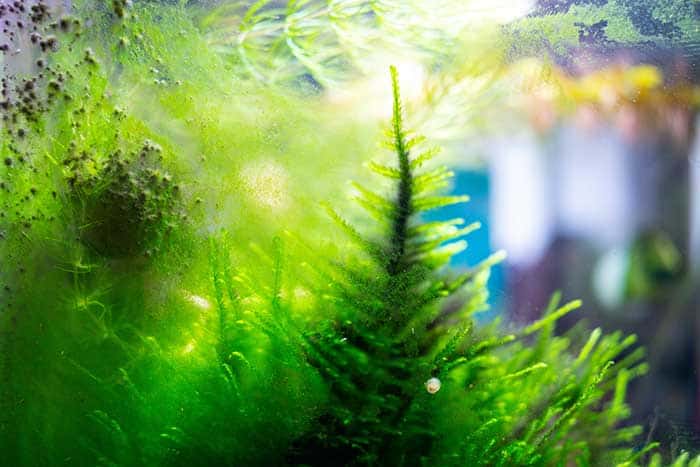13 Aquarium Plants That Grow On Rocks And Driftwood
Aquascaping is a popular aquarium hobby and is a whole subject within itself. Aquascaping is the perfect way to grow aquarium plants and bring some uniqueness to your fish tank.
There are hundreds of plant species that you can choose from to create an aquatic landscape, and this article focuses on some of the best aquarium plants that grow on rocks and driftwood.
Aquascaping is the process of using rocks, ornaments, wood, and live plants to craft an environment or ‘aquascape’ within your tank that is both beautiful to look at and provides a more natural environment for your fish, similar to their natural habitat.
Live plants also benefit your tank by aiding in the nitrogen cycle by reducing ammonia and nitrites while providing oxygen to the aquarium.
Aquarium plants have different root systems, and while many should be planted in soils and substrates, many plants thrive when free-floating. Some plants attach their roots to rocks, driftwood, and anything within reach.
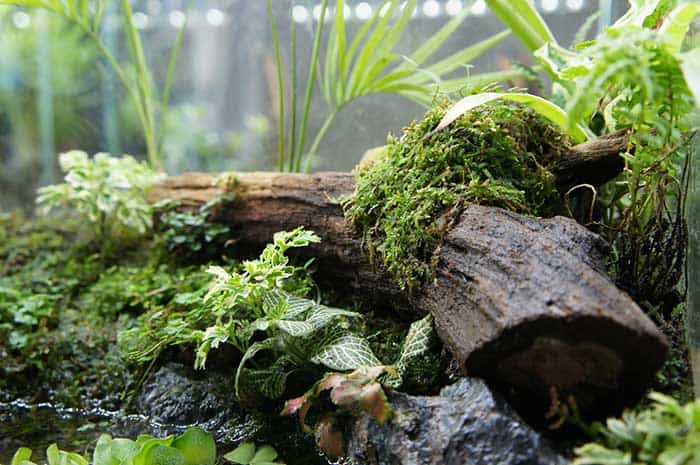
Because these aquarium plants grow and attach to objects in this way, it leaves a lot of creative scope for aquarists to create unique and beautiful aquascapes for their fish to inhabit.
If you are adding new aquarium plants to an established tank, it is important to consider quarantining them beforehand to avoid introducing parasites or diseases which the plant may have picked up.
I have an article that explains the quarantining process: How To Clean Aquarium Plants. The article also explains how to clean aquarium plants, especially when algae growth can deprive them of their required nutrients, essentially suffocating the plant.
This article covers 17 of the most widely used live aquarium plants that grow on rocks and driftwood, are easy to care for, and provide a wide variety of leaf types, colors, and styles for your planted tank.
Below is a list of what I consider to be some of the best aquarium plants for aquascaping, which can be attached to driftwood and rock.
I cover each of the aquatic plants below throughout this article.
- African Water Fern (Bolbitis Heudelotii)
- Anubias (Araceae Family)
- Christmas Moss (Vesicularia Montagnei)
- Cryptocoryne wendtii
- Crystalwort (Riccia Fluitans)
- Dwarf Baby Tears (Hemianthus)
- Dwarf Hygrophila (Hygrophila Pinnatifida)
- Flame Moss (Taxiphyllum sp. ‘Flame’)
- Moneywort (Bacopa Monnieri)
- Java Moss (Taxiphyllum Barbieri)
- Java Fern (Leptochilus Pteropus)
- Weeping Moss (Vesicularia Ferriei)
- Willow Moss (Fontinalis Antipyretica)
Before I talk more about these plants, I should add a short section on how to attach aquarium plants to driftwood and rock.
How To Attach Aquarium Plants To Driftwood And Rock
There are many different types of aquarium plants available, and one of the most important decisions you’ll need to make is how to attach them to driftwood or rock. There are a few different ways to attach plants, and the best choice for you depends on the type of plant and the size and shape of the driftwood or rock.
Aquarium moss is a popular choice for aquascaping as it is very versatile and easy to care for. There are many types of aquarium moss, some that grow upwards and some that grow outwards, but they all have excellent dense coverage and deep green hues.
Rhizomes are a type of branch that grows horizontally instead of vertically. The rhizome has both roots and leaves growing from it. The rhizome plants are the best aquarium plants for attaching to driftwood, rock, and other decorations.
Many aquarium plants that grow from rhizomes can be planted in soil, but the rhizome must remain above ground.
Rhizomes usually grow horizontally, growing along the object to which it has attached itself. The roots that grow from a rhizome generally grow down, and either the roots or the rhizome itself wraps around nearby objects. Usually, by attaching the rhizome to your desired piece of rock or driftwood, the roots quickly take hold naturally.
One option is to use a fishing line, a rubber band, or cotton thread. This method is quick and easy, but it’s not always very secure, so it’s not ideal for large or heavy plants. Cotton thread is also preferred as it dissolves over time when it’s no longer required.
Another option is to use aquarium-safe glue. Aquarium-safe super glue provides a more secure attachment but can be challenging to work with, and it isn’t always suitable for delicate plants.
Finally, you could use plant anchors, which are small weights that you can tie to the plant with a fishing line or cotton thread. Plant anchors are relatively inexpensive and easy to use, but they may not be suitable for all types of aquarium plants.
Ultimately, the best way to attach aquarium plants to driftwood or rock depends on your circumstances. There are many innovative ways to attach plants, but you don’t need to complicate the process.
Aquascaping Tools & Accessories
Below is a list of tools and accessories that you may find useful, including everything from Driftwood & Lava Rock to Wrapping Wire and Aquarium Safe Superglue.
- Spider Wood (Medium) Perfect For Aquariums And Terrariums – Compare Prices at Amazon & Chewy
- Natural, Sinkable Driftwood (Medium) – Compare Prices at Amazon & Chewy
- Lifeguard Aquatics Smokey Mountain Aquarium Rocks – Compare Prices at Amazon & Chewy
- Aquascaping Tool Kit (Scissors, Tweezers, Shapers, etc.) – Compare Prices at Amazon & Chewy
- API Leaf Zone Liquid Aquarium Fertilizer – Compare Prices at Amazon & Chewy
- API Co2 Booster For Aquarium Plant Growth – Compare Prices at Amazon & Chewy
- Aquarium Safe Epoxy (Chewy) & Glue (Amazon) For Attaching Rocks And Plants – Compare Prices
All of the above are recommendations. There are several variations available.
So let’s talk about which plants to use and why.
African Water Fern (Bolbitis Heudelotii)
| Plant Information Chart | Value |
|---|---|
| Name | African Water Fern |
| Scientific Name | Bolbitis Heudleotii |
| Plant Family | Lomariopsidaceae |
| Origin | Africa |
| Care Level | Easy |
| Lighting | Low-High |
| Growth Rate | Slow |
| Size | Up to 22 Inches |
| Minimum Tank Size | 20 Gallons |
| Water Temperature | 70ºF – 84°F |
| pH Range | 6.0 – 8.5 |
| Tank Placement | Midground, Background |
The African water fern is commonly found in flowing streams and boggy areas around Africa. They can also be found in the Congo River basin and are often known as the Congo fern.
The African water fern is a slow-growing plant but can become quite big with large dark green leaves over time, making it unsuitable for small tanks and nano aquariums.
Most tank conditions are favorable for African water ferns, as they only require low to moderate lighting throughout the day and a reasonable period of darkness at night.
The Bolbitis Heudelotii will feed on the ammonia and nitrites left by fish waste, or you can add commercial fertilizer. Their speed of growth can be increased by carbon dioxide injection or supplementation.
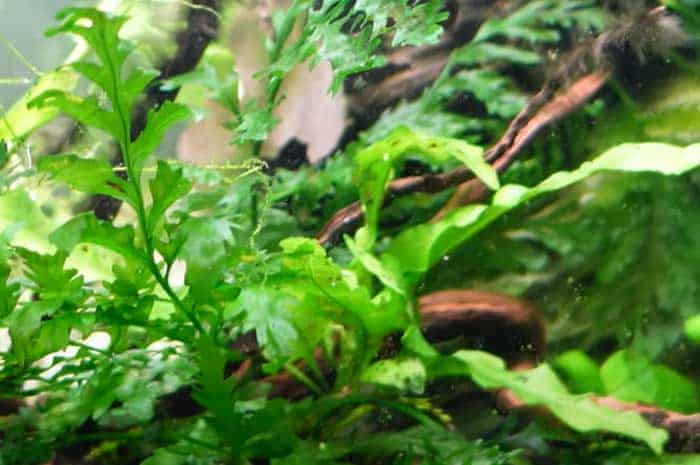
Where To Buy African Water Fern
African Water Fern is available to buy in many local aquariums or it can be sourced online.
Amazon has a wide range of aquatic plant suppliers, and you can buy African Water Fern at the (affiliate) link below.
African Water Fern – Blobitus Heudelotii (Buy 2 Get 1 Free) – At Amazon
How To Attach African Water Fern To Rock And Driftwood
African water ferns grow from rhizomes, making them suitable for attaching to rocks and driftwood with cotton thread or an elastic band until the roots take hold. You can also use Aquarium-safe super glue along the rhizome without causing any harm.
If you choose to plant the African fern, you should ensure that only the roots are beneath the substrate, as the rhizome will rot if buried and also obstructs its growth.
Anubias (Araceae Family)
| Plant Information Chart | Value |
|---|---|
| Name | Anubias Barteri |
| Scientific Name | Anubias Barteri |
| Plant Family | Araceae |
| Origin | Central & Western Africa |
| Care Level | Easy |
| Lighting | Low-High |
| Growth Rate | Slow-Moderate |
| Maximum Size | 16 Inches |
| Minimum Tank Size | 10 Gallons |
| Water Temperature | 72ºF – 82°F |
| pH Range | 6.5-7.8 |
| Tank Placement | Foreground, Midground, Background |
Anubias is a popular aquarium plant from the Araceae family, which are aquatic or semi-aquatic, with many varieties suitable for attaching to driftwood and rock.
Because there are so many forms, I will focus on the most popular among aquarists, Anubias barteri (which also has many varieties).
Some Anubias barteri varieties are:
- Anubias barteri var. angustifolia
- Anubias barteri var. barteri
- Anubias barteri var. caladiifolia
- Anubias barteri var. glabra
- Anubias barteri var. nana
Anubias plants are native to central and western Africa and are typically found in and alongside flowing rivers and streams but can also be found in slow-moving marshes.
Anubias is a hardy plant popular with aquarists because of its low care needs and nutrient requirements.
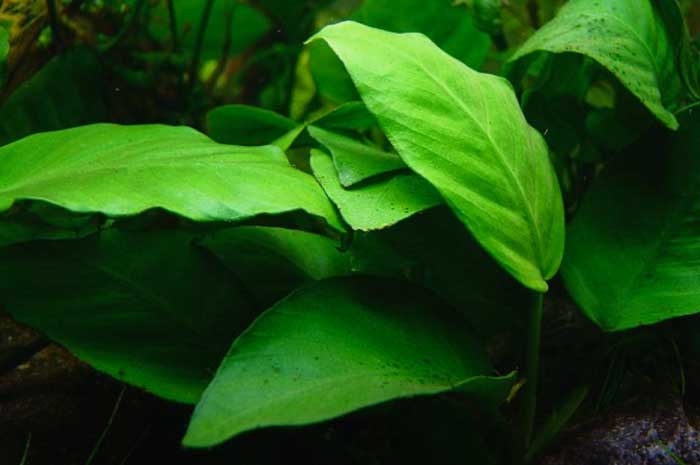
Anubias plants are slow-growing with bright green leaves. They can develop small underwater flowers, which also grow slowly, only lasting a few weeks at a time.
Although Anubias can be planted, it is not recommended as they are more likely to thrive when attached to rock or driftwood with their roots and rhizome exposed to absorb nutrients directly from the water. Burying the rhizome beneath the substrate heavily restricts growth and nutrient uptake.
Where To Buy Anubias
Anubias are available to buy in many local aquariums, or they can be sourced online.
Amazon has a wide range of aquatic plant suppliers, and you can buy Anubias at the (affiliate) links below.
How To Attach Anubias To Driftwood And Rock
Anubias make excellent driftwood aquarium plants that also look great on aquarium rock or any other decoration. Anubias attach themselves naturally as they sprout roots from the rhizome.
You can tie the anubias rhizome with cotton thread or thin elastic bands, or you can also use aquarium-safe glue to attach the rhizome directly until its roots grow.
The main goal is to attach the anubias to stay in place until they have time to attach themselves, so you can even wedge these aquarium plants in place if you feel they will be secure and not float away.
I found the video below on Youtube, which details some of the steps you can take to attach your anubias to rock and driftwood.
Christmas Moss (Vesicularia Montagnei)
| Plant Information Chart | Value |
|---|---|
| Name | Christmas Moss |
| Scientific Name | Vesicularia Montagnei |
| Plant Family | Hypnaceae |
| Origin | Asia (India, Thailand, Japan, Philippines) |
| Care Level | Medium |
| Lighting | Medium-High |
| Growth Rate | Moderate |
| Size | 4-14 Inches |
| Minimum Tank Size | Any |
| Water Temperature | 72ºF – 82°F |
| pH Range | 5.0-7.5 |
| Tank Placement | Carpeting Or Attached |
Christmas moss is native to Asia and can be found throughout India, Thailand, Japan, and the Philippines, usually growing in streams or on riverbanks.
All types of moss are stunning additions to any aquarium, especially when used in aquascaping, and Christmas moss is no exception.
Christmas moss looks similar to a fir tree hence the name, but it grows horizontally along its rhizome, making it an excellent carpeting plant.
Christmas moss is very easy to care for, and it accepts a wide range of conditions, making it suitable for most community tanks. Its growth rate is dependent on how much light and nutrients are available to it.
Like most other moss types, Christmas moss is easy to attach and cultivate however you choose. It has a shallow root structure which enables it to absorb adequate nutrients directly from the water.
Although Christmas moss is best attached to decor, it can survive when free-floating and eventually finds somewhere to attach itself.
Christmas moss is ideal if you want to carpet your tank base, and there are many great examples of this plant being attached to driftwood or spider wood to simulate aquatic trees.
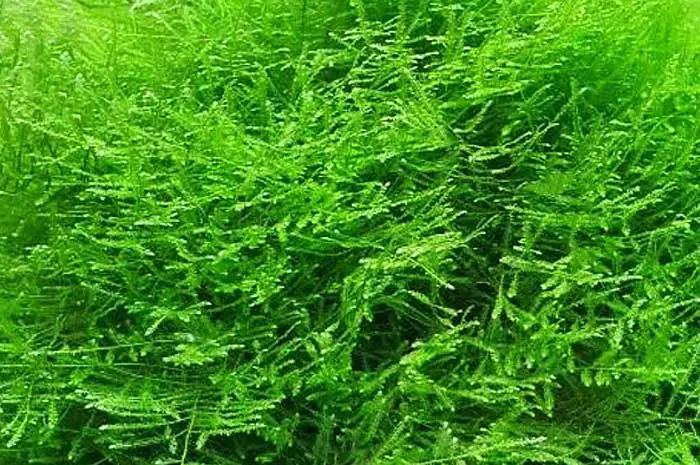
Where To Buy Christmas Moss
Christmas Moss can be purchased in some local aquariums, or it can be sourced online.
Amazon has a wide range of aquatic plant suppliers, and you can buy Christmas Moss at the (affiliate) links below.
How To Attach Christmas Moss To Driftwood And Rock
Like many types of aquatic moss, Christmas moss is very easy to attach, and if left unattached, it often finds somewhere to attach all by itself.
You can initially anchor Christmas moss with cotton thread, small elastic bands, or glue, which depends on your mounting requirements.
If you are carpeting the tank floor, simply weighing the moss down will usually suffice; however, if you want to get creative and attach the moss to tree branches, you can apply aquarium-safe super glue to the branches and attach the moss directly.
Cotton thread or elastic bands are not as easy to use when attaching the moss to certain areas, but cotton or elastic is enough to create the initial anchor if you want the moss to grow up a wall or around a rock.
Cryptocoryne wendtii
| Plant Information Chart | Value |
|---|---|
| Name | Cryptocoryne Wendtii |
| Scientific Name | Cryptocoryne Wendtii |
| Plant Family | Araceae |
| Origin | Sri Lanka, Asia |
| Care Level | Easy |
| Lighting | Low-High |
| Growth Rate | Slow |
| Size | 5-18 Inches |
| Minimum Tank Size | 20 Gallons |
| Water Temperature | 68ºF – 82°F (Requires Stable Conditions) |
| pH Range | 6.8-7.2 (Requires Stable Conditions) |
| Tank Placement | Midground, Background |
Many species of Cryptocoryne are popular in aquariums, and Cryptocoryne wendtii is one of the most popular.
Cryptocoryne wendtii is native to the island of Sri Lanka and comes in many forms, such as:
- Cryptocoryne wendtii ‘Green’
- Cryptocoryne wendtii ‘Brown’
- Cryptocoryne wendtii ‘Tropica’
- Cryptocoryne wendtii ‘Red’
- Cryptocoryne wendtii ‘Mi Oya’
Each form has a vastly different appearance, especially in color, but their care needs are similar.
Cryptocoryne wendtii tends to grow an extensive root network and will thrive best when planted in a nutrient-rich substrate, but they are also quite commonly attached to driftwood and even rock, where growth is slower, and the roots still try to find the substrate.
Cryptocoryne wendtii is a hardy aquarium plant that will survive in most conditions providing they are stable. Often when you introduce this plant to a new aquarium, it will look like it is dying, but as it adjusts to the water conditions, it will usually revive.
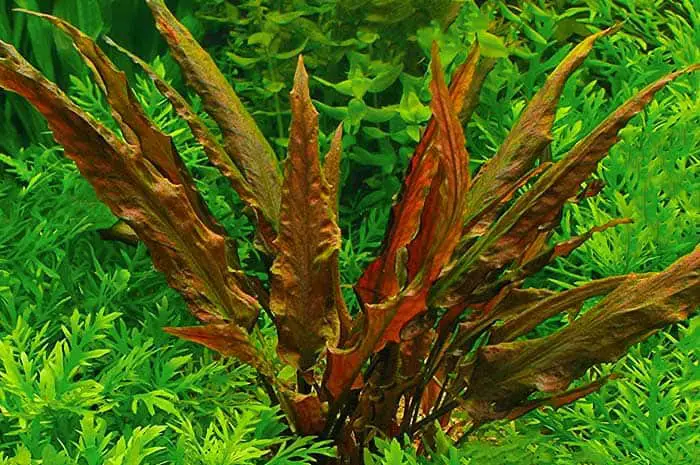
Whether you decide to mount this plant on some driftwood or rock, use it as some backing to your aquarium, or split up other foliage with its bright colors, each variety can be vastly different in size, ranging from 5 to 18 inches. Some types can grow very tall and would be perfect as a backing plant, whereas some plants will be very short and more suitable for mounting.
Where To Buy Cryptocoryne Wendtii
Cryptocoryne wendtii can be purchased in some local aquariums, or it can be sourced online.
Amazon has a wide range of aquatic plant suppliers, and you can buy Cryptocoryne wendtii at the (affiliate) links below.
- Buy Cryptocoryne wendtii ‘Red’ at Amazon (Mainam)
- Buy Cryptocoryne wendtii ‘Red’ (Buy 2 Get 1 Free) at Amazon (Planterest)
- Buy Cryptocoryne wendtii ‘Green’ at Amazon (Greenpro)
- Buy Cryptocoryne wendtii ‘Green’ (Buy 2 Get 1 Free) at Amazon (Planterest)
- Cryptocoryne wendtii ‘Green’ Mounted On Driftwood at Amazon (Greenpro)
How To Attach Cryptocorne Wendtii To Driftwood And Rock
Cryptocoryne wendtii can be mounted using string, cotton thread, rubber bands, or glue, similar to the other plants already discussed. It is best mounted at the tank’s base, where the root system can trail down into the substrate for extra nutrition.
The rhizomes of this crypt allow it to grow adjacently and can look quite attractive when attached to wood or rock in the right way.
Crystalwort (Riccia Fluitans)
| Plant Information Chart | Value |
|---|---|
| Name | Crystalwort |
| Scientific Name | Riccia Fluitans |
| Plant Family | Ricciaceae |
| Origin | Worldwide (Commonly Africa, Asia, and the Americas) |
| Care Level | Easy-Medium |
| Lighting | Medium-High |
| Growth Rate | Fast |
| Size | 1.2 inches |
| Minimum Tank Size | 5 Gallons |
| Water Temperature | 68ºF – 82°F |
| pH Range | 6.0-8.0 |
| Tank Placement | Foreground, Midground, Floating, Carpeting |
Crystalwort is a floating plant, also known as floating moss and floating liverwort. Crystalwort has a moss-like appearance and growth, making it very suitable for aquascaping as it attaches easily to most things.
Crystalwort can be found worldwide and is widespread in Africa, Asia, and the Americas. Crystalwort is an amphibious plant located on the moist soil of riverbanks, floating in shallow water or completely submerged, attached to the bottom.
Crystalwort prefers slow-moving water and can adapt to most tank conditions, like those found in most community tanks. Submersed plants prefer stronger light if possible.
The general structure of Crystalwort is similar to moss, with a thallus which is a body that is not differentiated into stems and leaves. The thallus branches out by forming numerous bright green shoots.
Crystalwort is an excellent carpeting plant and can be used creatively on driftwood, spider wood, or rocks to form a wall when growing up. Its shoots remain pretty short and can be easily trimmed and shaped.
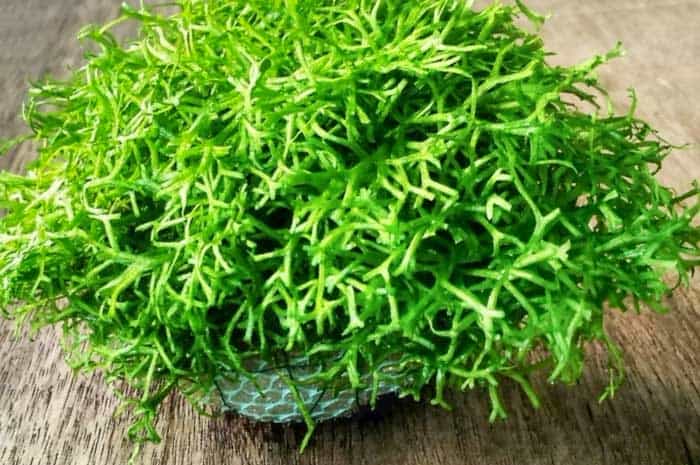
Where To Buy Crystalwort
Crystalwort (Riccia Fluitans) can be purchased in some local aquariums, or it can be sourced online.
Amazon has a wide range of aquatic plant suppliers, and you can buy Crystalwort at the (affiliate) link below.
How To Attach Crystalwort To Driftwood Or Rock
As stated above, Crystalwort is pretty easy to attach to most things, so the initial attachment can be with a simple piece of thread or some small elastic bands. For more precise attachment, you can use super glue.
If you are using Crystalwort for carpeting the base of your tank, you can use some weights to stop the plant from floating around until it naturally attaches itself.
Apply some glue to the driftwood or rock and hold the moss firmly until the glue has set. Once the adhesive becomes submerged in water, it sets hard. If using super glue, it is best done outside of the tank in dry conditions until the glue sets.
Superglue doesn’t damage the plant or restrict root growth.
Dwarf Baby Tears (Hemianthus)
| Plant Information Chart | Value |
|---|---|
| Name | Dwarf Baby Tears |
| Scientific Name | Hemianthus |
| Plant Family | Linderniaceae |
| Origin | Cuba, Puerto Rico, Bahamas |
| Care Level | Easy |
| Lighting | High |
| Growth Rate | Slow-Moderate |
| Size | 1-2 Inches |
| Minimum Tank Size | Any |
| Water Temperature | 68ºF – 75°F |
| pH Range | 6.0-7.5 |
| Tank Placement | Foreground, Midground, Carpeting |
Dwarf Baby Tears is another excellent carpeting plant used widely for carpeting entire tanks. Also known as Water Starwort, it is natively found in Cuba, Puerto Rico, and the Bahamas. Its small leaves nest together tightly, creating a beautiful mat of bright green.
Because of its small size, Dwarf Baby Tears is generally considered a foreground plant, suitable for planting in the substrate, and very suitable for growing on rock or driftwood.
Dwarf Baby Tears does have some specific care needs, such as plenty of light, regular fertilization, and the addition of carbon dioxide is beneficial to aid in healthy growth. This aquarium plant is known for its very slow growth, making it suitable for smaller or nano tanks, but regular trimming of the leaves is required. Because the leaves of this plant are so tightly nested, new growth can strangle the leaves below.
Although Dwarf Baby Tears will grow well in the substrate, they will also grow well on rock and wood and can even grow better with their roots out of the substrate.
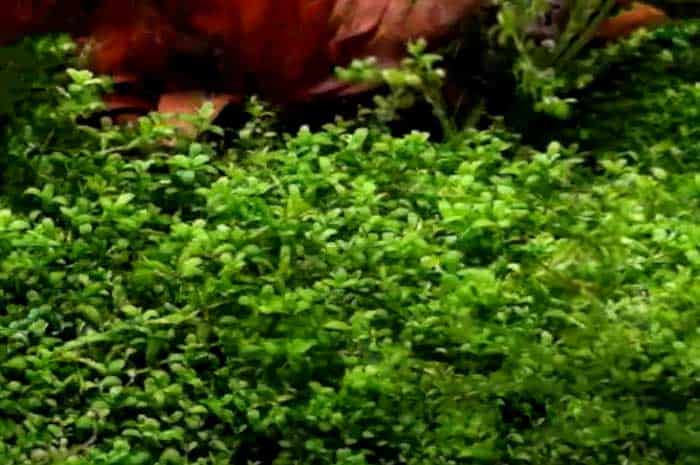
Where To Buy Dwarf Baby Tears
Dwarf Baby Tears (Hemianthus) can be purchased in some local aquariums, or they can be sourced online.
Amazon has a wide range of aquatic plant suppliers, and you can buy Dwarf Baby Tears at the (affiliate) links below.
How To Attach Dwarf Baby Tears To Driftwood Or Rock
Dwarf Baby Tears can be attached to driftwood and rock in the same way as most plants in this list. Simply securing the plant with thread or elastic is the best method, and when using it for carpeting the base of the tank, you can wedge or weigh it down.
Because of the slow growth of this aquarium plant, it may take a while before it becomes naturally attached. You need to ensure the initial anchor is sufficient to hold it in place until it has anchored itself.
Dwarf Hygrophila (Hygrophila Pinnatifida)
| Plant Information Chart | Value |
|---|---|
| Name | Dwarf Hygrophila |
| Scientific Name | Hygrophila Pinnatifida |
| Plant Family | Acanthaceae |
| Origin | India |
| Care Level | Easy, Medium |
| Lighting | Medium-High |
| Growth Rate | Slow-Moderate |
| Size | 5-8 Inches |
| Minimum Tank Size | 20 Gallons |
| Water Temperature | 70ºF – 80°F |
| pH Range | 6.0-7.5 |
| Tank Placement | Foreground, Midground |
Dwarf Hygrophilia, also known as Dwarf Hygro, is an aquarium plant native to India that has become popular among aquarists in recent years because of its easy care needs and variety of uses.
Although Dwarf Hygro is a stem plant, it is also an epiphyte that doesn’t need a substrate to grow. Instead, it can grow upon another plant or object and take nutrients directly from the aquarium water.
Hygrophila Pinnatifida has a unique look, with fern-like leaves that can turn red in well-lit aquariums with high carbon dioxide levels. This aquarium plant is quite aggressive and fast-growing, regularly sending out new shoots, making attaching it to rock and wood relatively easy.
Trimming the top of this plant helps it grow more densely and stops it from shadowing other aquarium plants. You will also need to trim the runners frequently, or they can quickly take over your tank.
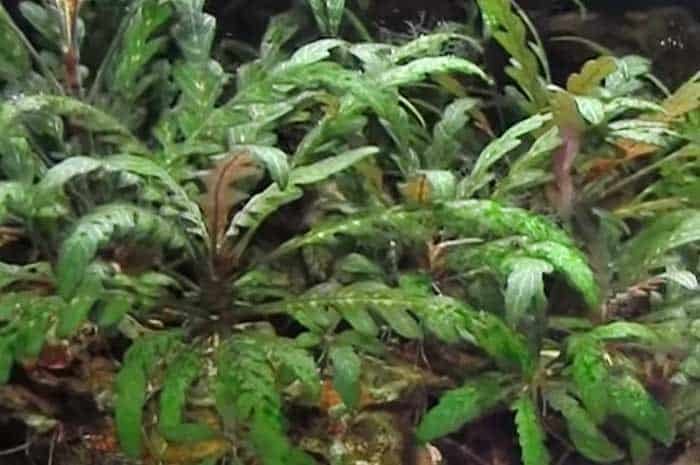
Where To Buy Dwarf Hygrophila
Dwarf Hygro (Hygrophila Pinnatifida) can be purchased in some local aquariums, or they can be sourced online.
Amazon has a wide range of aquatic plant suppliers, and you can buy Dwarf Hygro at the (affiliate) links below.
How To Attach Hygrophila Pinnatifida To Driftwood And Rock
Attaching Hygrophila Pinnatifida is simple to do. You need to attach the plant’s rhizomes with fishing line, thread, or super glue. New rhizomes grow very quickly, which secures this aquatic plant quite firmly.
You may find that using a combination of attachments can help with a more secure initial attachment because the stem of this plant makes it top-heavy, or you can just trim it down to make it easier to handle.
Flame Moss (Taxiphyllum sp. ‘Flame’)
| Plant Information Chart | Value |
|---|---|
| Name | Flame Moss |
| Scientific Name | Taxiphyllum sp. ‘Flame’ |
| Plant Family | Hypnaceae |
| Origin | South & Southeast Asia |
| Care Level | Moderate |
| Lighting | Low |
| Growth Rate | Slow |
| Size | 4-6 Inches |
| Minimum Tank Size | 10 Gallons |
| Water Temperature | 72ºF – 82°F |
| pH Range | 6.0-7.5 |
| Tank Placement | Foreground, Midground |
Flame moss is quite a unique moss type, native to South Asia and Southeast Asia. Its uniqueness comes in the way that it grows. Most types of moss are short and grow horizontally, making them perfect carpeting plants, whereas Flame moss mainly grows upwards.
Flame moss grows in a unique upward-twisting pattern that looks like a burning flame, enhanced by its intense emerald-green coloring. Many people use moss to create unique looks for their aquascapes, and Flame moss can add even more variety.
Flame mosses are happy in general aquarium water conditions with soft lighting, an average temperature, and a neutral to slightly alkaline pH. Flame moss prefers a weaker current because its root system is quite delicate, growing from several rhizoids, enabling it to attach easily to most objects. Still, strong water currents can detach it just as easily.
Flame moss is pretty slow growing, like most types of moss, but with sufficient nutrients, light, and carbon dioxide, you can enhance the growth rate to some degree.
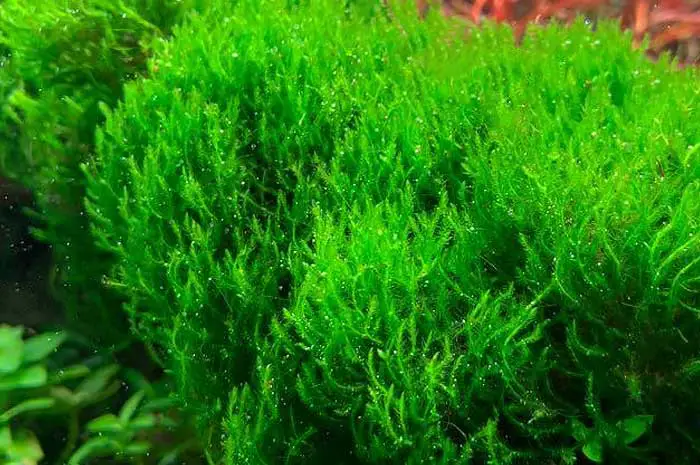
Where To Buy Flame Moss
Flame Moss (Taxiphyllum sp. ‘Flame’) can be purchased in some local aquariums or they can be sourced online.
Amazon has a wide range of aquatic plant suppliers, and you can buy Flame Moss at the (affiliate) links below.
How To Attach Flame Moss To Driftwood And Rock
Flame moss attaches to driftwood, rock, and any other decor like other rhizoid plants, although the roots are generally quite small, which causes the natural attachment to be quite weak.
Before attaching your Flame moss, you need to decide where to place it within the tank. Ideally, find an area not in direct line with a strong current. Strong currents can easily detach this long grassy moss.
Cotton or fishing line should anchor the rhizoids quite tightly, and you may want to add some super glue to the driftwood or rock that you are attaching it to for extra measure.
Although the roots attach themselves over time, this moss will never forms an unbreakable bond, so aquarium-safe super glue is a good option. Glue creates a permanent bond that remains largely hidden.
Moneywort (Bacopa Monnieri)
| Plant Information Chart | Value |
|---|---|
| Name | Moneywort |
| Scientific Name | Bacopa Monnieri |
| Plant Family | Scropulariacase |
| Origin | South America, Asia, Australia, Africa |
| Care Level | Easy-Moderate |
| Lighting | Low-Medium |
| Growth Rate | Slow |
| Size | 8-12 Inches |
| Minimum Tank Size | 10 Gallons |
| Water Temperature | 72ºF – 82°F |
| pH Range | 6.0-7.5 |
| Tank Placement | Midground, Background |
Moneywort, also known as water hyssop, is a popular aquarium plant commonly found growing in the marshes and wetlands of South America, Asia, Australia, and Africa. Its popularity comes from its hardiness, ease of care, and many uses.
Moneywort is a creeping stem plant that can be planted in substrate or free-floating as it can absorb nutrients directly from the aquarium water. These versatile aquarium plants can also be used to carpet your tank, although the growth will be higher than most aquarium plants that grow in this way.
The leaves of Moneywart plants are pretty small (usually about 1 inch) with thick, sturdy stems that support these aquatic plants well, even in stronger currents. The bright green leaves look lovely in any aquarium, and they can bloom with small white flowers, often with a hint of pink or purple.
Because these plants don’t require a substrate, you can attach them to driftwood, aquarium rocks, or any other decoration in your tank, and they still thrive. With regular trimming, they remain compact, or you can allow them to cover a wider area.
Moneywort is suitable for most tank conditions with a pH between 6 and 7.5, a temperature between 72°F and 82°F, and water hardness between 5 and 20 dKH. Average lighting with around 10-12 hours of light through the day and 10-12 hours of darkness is adequate.
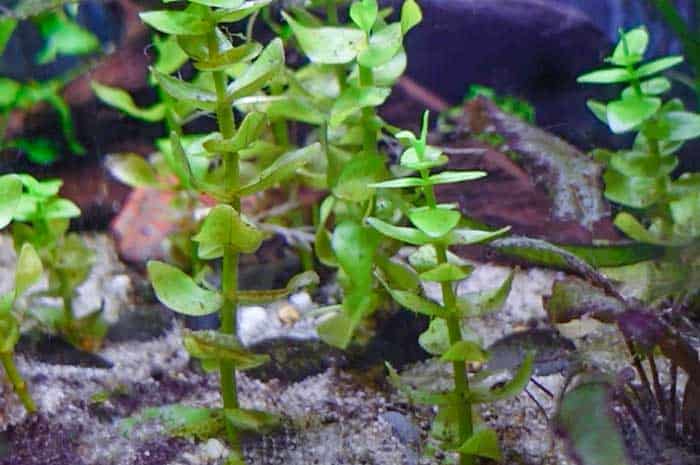
Where To Buy Moneywort
Moneywort (Bacopa Monnieri) can be purchased in some local aquariums, or it can be sourced online.
Amazon has a wide range of aquatic plant suppliers, and you can buy Moneywort at the (affiliate) links below.
How To Attach Moneywort To Driftwood And Rock
The usual methods used to attach live plants to driftwood or rock can be employed with Moneywort. These aquatic plants will grow side shoots or rhizomes, which can be secured with cotton thread, fishing line, or aquarium-safe super glue until further shoots grow and anchor the plant naturally.
If you plan to let this plant grow quite tall you need a heavier piece of wood or rock to mount it onto. Otherwise, it easily moves around the tank with the current.
Java Moss (Taxiphyllum Barbieri)
| Plant Information Chart | Value |
|---|---|
| Name | Java Moss |
| Scientific Name | Taxiphyllum Barbieri |
| Plant Family | Hypnaceae |
| Origin | Southeast Asia |
| Care Level | Easy |
| Lighting | Low-Medium |
| Growth Rate | Slow |
| Size | 2-4 Inches |
| Minimum Tank Size | Any |
| Water Temperature | 62ºF – 86°F |
| pH Range | 6.0-8.0 |
| Tank Placement | Foreground, Midground, Background, Carpeting |
If you have researched aquarium plants or aquascaping, you’ve probably heard the name Java moss quite frequently. Java moss is commonly found in planted aquariums because of its versatility, low care needs, and great looks.
Java moss can be found in many tropical countries, growing along rocks and riverbanks. Java moss is native to many parts of Southeast Asia and, more precisely, the island of Java in Indonesia.
Java moss can grow anywhere in an aquarium and doesn’t need substrate. Java moss is exceptionally hardy and suitable for all but the most extreme tank conditions.
The rhizoids that grow from the Java moss are where new shoots grow from and allow them to be attached to most things, including driftwood and rocks.
Java moss is a beautiful dense green moss type, ideal for carpeting the tank floor or forming thick moss walls. Java moss on driftwood looks excellent in any aquarium, and if you are new to aquascaping, I would consider it the best moss for driftwood or rocks.
Newly sprouted shoots will have a light green appearance, gradually turning into a deeper green as it ages.
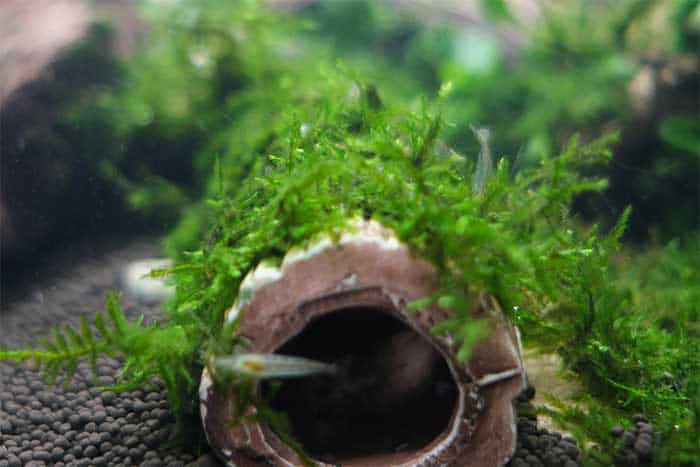
Where To Buy Java Moss
Java Moss (Taxiphyllum Barbieri) can be purchased in some local aquariums or they can be sourced online.
Amazon has a wide range of aquatic plant suppliers, and you can buy Java Moss at the (affiliate) links below.
How To Attach Java Moss To Driftwood And Rock
Attaching Java moss to driftwood is a common practice in aquascaping. It is also commonly attached to spider wood or bonsai trunks to give the appearance of a living underwater forest.
Understanding how to attach Java moss to driftwood ensures that it will look its best and is easy to maintain.
If you are creating an underwater tree, you need to use a discarded bonsai trunk or some spider wood that resembles a tree trunk. Ideally, you should apply some aquarium-safe super glue gel to some of the branches (especially the tips) where the Java moss looks best.
Cut your Java moss to the correct shape and press firmly to the wood until it bonds, and consider tying a small amount of cotton thread to ensure it remains in place.
The glue becomes hard when submerged in water, and as new roots appear, they anchor to the branches firmly. Regular trimming allows you to keep the Java moss from overgrowth, and you can shape it around the bonsai branches in whatever style you choose.
So how to attach Java moss to rock? As the rhizomes shoot outwards, this moss quickly covers whatever it has become attached to and only requires trimming to prevent overgrowth. Glue and cotton thread can also be used when attaching Java moss to rock, but you should leave room for it to grow outwards.
Java Fern (Microsorum Pteropus)
| Plant Information Chart | Value |
|---|---|
| Name | Java Fern |
| Scientific Name | Microsorum Pteropus |
| Plant Family | Polypodiaceae |
| Origin | Southeast Asia |
| Care Level | Easy |
| Lighting | Low-Medium |
| Growth Rate | Slow |
| Size | 12-14 Inches |
| Minimum Tank Size | 10 Gallons |
| Water Temperature | 68ºF – 80°F |
| pH Range | 6.0-7.5 |
| Tank Placement | Midground, Background |
Java fern is a freshwater aquarium plant native to Southeast Asia, and like Java moss, it originates explicitly from the Indonesian island of Java. They have long, bright green leaves which can brighten any dull aquarium.
There are several types of Java ferns that all differ slightly in leaf shape and growth size, but their care needs are all very similar. Java ferns are hardy aquatic plants that grow from rhizomes which help them attach to surfaces quite easily.
The Java fern doesn’t need to be planted in the substrate as it will absorb nutrients directly from the aquarium water through its leaves and roots. These plants generally grow slowly, usually 1 inch per month, but they may grow slightly quicker with the addition of liquid fertilizers and carbon dioxide injection.
As Java ferns are typically found in shady and humid jungle environments and do best if you can replicate these conditions in your aquarium setting. Ideally, you should avoid long hours of intense light, keep your temperature between 68°F-80°F, and your tank pH between 6.0-7.5 (or slightly acidic).
As Java ferns can grow quite tall, they ideally suit a midground or background-position. When attached to wood or rock, Java ferns grow horizontal shoots or rhizomes, which eventually help them cover more densely.
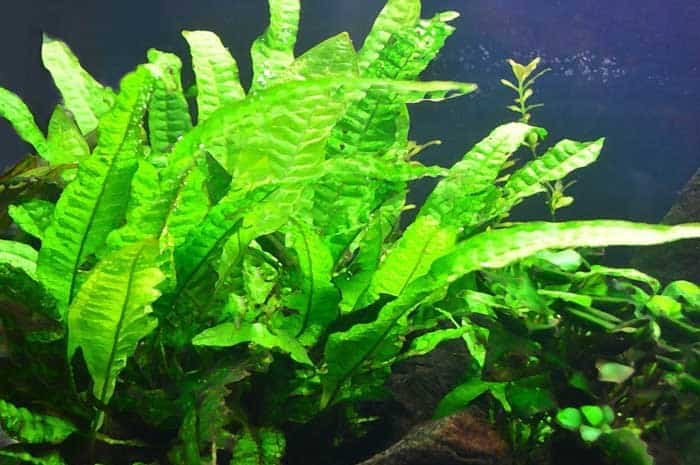
Where To Buy Java Fern
Java Fern (Microsorum Pteropus) can be purchased in some local aquariums, or they can be sourced online.
Amazon has a wide range of aquatic plant suppliers, and you can buy Java Fern at the (affiliate) links below.
How To Attach Java Fern To Driftwood Or Rock
Attaching Java fern to driftwood or rock is the same as attaching all rhizome-type plants, but there are always some slight variations or considerations to each one which I will mention.
So, how to attach Java fern to driftwood? You should first consider where you would like to attach your Java fern and think how tall it is likely to grow. If your driftwood is placed at an angle or higher in the tank, remember that the Java fern can grow quite tall, and they prefer the shadier areas at the base of the aquarium. If your driftwood remains at the bottom of the tank, you are good to go.
The rhizomes are the strongest part of the Java fern, and these can be attached quite firmly with cotton or fishing line. Super glue is often easier to use, but it can sometimes break away from wood, even when it sets hard.
Ensure you secure the rhizomes along the wood in the direction you would like your Java fern to grow. Sometimes people wrap the rhizome around the wood instead. Because leaves and roots grow from the rhizome, by wrapping it, you will cause growth in several directions, both up and down, and it takes much longer to grow sideways.
How to attach Java Fern to rock? Try not to use a rock that has a large base. As the rhizomes grow roots, they need to wrap around the rock to attach firmly, so smaller rocks or rocks with plenty of ridges are preferable.
Super glue is favorable when used on rock as it generally sets hard. Find the best area of rock to cover with your Java fern, and add plenty of glue. Make sure any roots that have already formed are split to wrap both sides of the rock, and then press the rhizome firmly onto the glue until it sets.
Once the rock returns to the water, the glue will harden further until solid.
Weeping Moss (Vesicularia Ferriei)
| Plant Information Chart | Value |
|---|---|
| Name | Weeping Moss |
| Scientific Name | Vesicularia Ferriei |
| Plant Family | Hypnaceae |
| Origin | China (Found Throughout Asia & Europe) |
| Care Level | Easy-Medium |
| Lighting | Low-Medium |
| Growth Rate | Slow |
| Size | 1 Inch |
| Minimum Tank Size | 5 Gallons |
| Water Temperature | 70ºF – 82°F |
| pH Range | 5.0-7.0 |
| Tank Placement | Foreground, Midground, Background |
Another popular moss for aquascaping is Weeping moss or Vesicularia ferriei. This aquarium plant has long, bright green leaves with a trailing growth habit that is particularly suited to adding detail or highlights in aquariums.
Weeping moss is native to China but can be found throughout Asia and Europe, usually on wet rocks and damp soil near riverbanks and streams. This moss has a similar look to a weeping willow because its shoots and leaves tend to grow downwards.
Weeping moss does not have roots to absorb nutrients and instead has rhizoids, which are small root-like structures that anchor the plant to its rocky or driftwood home. This plant will take nutrients directly from the water column.
This aquarium plant is relatively easy to grow and requires little maintenance despite not having roots. It can thrive in aquariums with a wide range of water conditions and temperatures, making it an ideal choice for any aquarium hobbyist looking to add some color.
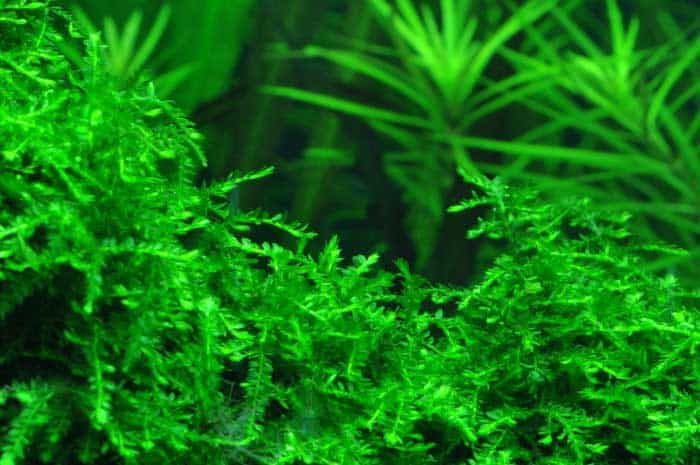
Where To Buy Weeping Moss
Weeping Moss (Vesicularia Ferriei) can be purchased in some local aquariums or they can be sourced online.
Amazon has a wide range of aquatic plant suppliers, and you can buy Weeping Moss at the (affiliate) links below.
How To Attach Weeping Moss To Driftwood
Weeping moss is one of the easiest plants to attach to driftwood, and one of the best methods is to use some thread. You need to identify the most natural position to attach the weeping moss and take into account that as it thickens, it hangs downwards.
Once you have the weeping moss in place, you should wrap the thread around the wood and moss, leaving 1cm gaps, and then wind the thread back to where you started, where you can tie it off.
The willow moss should attach quickly through the growth of new rhizoids, which wrap around the driftwood, anchoring it firmly in place.
How To Attach Weeping Moss To Rock
You can attach weeping moss to rock the same way you would attach it to driftwood. You can also attach it with super glue but only do this to a dry rock surface. You need to remove as much moisture as possible from the moss by dabbing on a kitchen towel.
If you are using a large piece of rock, you should identify areas that have ridges and crevices where the weeping moss can cling naturally.
Willow Moss (Fontinalis Antipyretica)
| Plant Information Chart | Value |
|---|---|
| Name | Willow Moss |
| Scientific Name | Fontinalis Antipyretica |
| Plant Family | Fontinalaceae |
| Origin | North America (Also found throughout Europe, Asia, Africa) |
| Care Level | Easy |
| Lighting | Low-High |
| Growth Rate | Slow, Moderate |
| Size | Up To 20 Inches |
| Minimum Tank Size | 20 Gallons |
| Water Temperature | 59ºF – 82°F |
| pH Range | 5.5-7.5 |
| Tank Placement | Foreground, Midground, Background |
Our final plant in this list is the Willow moss, which is similar to the Weeping moss I previously discussed, except the shoots and leaves grow upwards.
Willow moss is native to North America, but it’s widely found in many areas of Europe, Asia, and Africa. Willow moss does well in most conditions and can be found in fast-flowing streams and rivers or quiet ponds and lakes.
When left to grow, the shoots on this plant can grow to around 20 inches in length, making it an ideal midground or background plant, and it will thrive without substrate as a free-floating plant or attached to some decor.
Willow moss can live in various tank conditions, between temperatures of 59°F to 82°F and a pH between 5.5-8.5. Although Willow moss prefers medium to low lighting levels, it can tolerate stronger lighting. However, direct sunlight is not advised.
Willow moss also has many benefits for aquariums as it is an excellent oxygenating plant and can absorb many heavy metals.
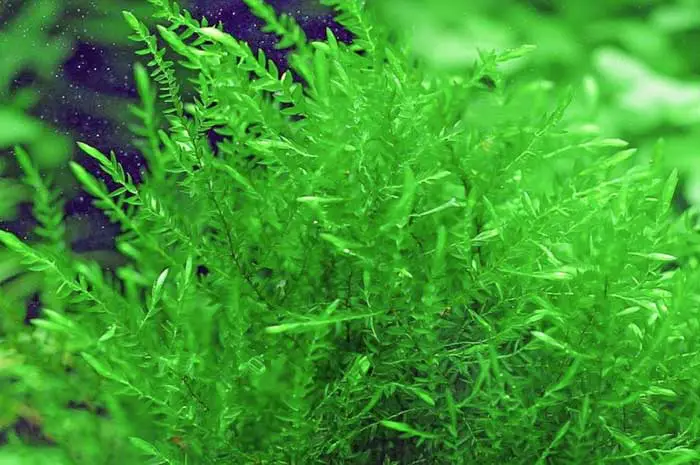
How To Attach Willow Moss To Driftwood And Rock
Willow moss can be planted on the substrate or attached to driftwood and rock. This plant grows through stolons which are long runners that grow rhizoids that let it attach to most aquatic decor.
Attaching Willow moss to driftwood or rock is much the same as attaching any moss variety, and the use of thread, elastic band, or super glue is the favored method.
Make sure to mount the Willow moss to a suitable area where the rhizoids can attach naturally and bind it firmly with your chosen material. Willow moss usually attaches within 2-4 weeks, and the thread or elastic dissolves over time.
Willow moss is a true aquatic plant that likes to remain submerged, so you should attach it somewhere near the base of the tank, where it does best.
Wrap Up
Although I have covered many aquarium plants that grow on both driftwood and rock, there are numerous variations and species that I have left out.
Throughout this article, I included links to where you can buy each specific plant online. I thought it would be useful to link to each of the suppliers that I have purchased plants from on Amazon because they have many varieties, not easily available in stores.
Buy Plants From (PLANTEREST) on Amazon
Planterest is a retailer I use often on Amazon. They have many plant discounts (generally Buy 2 Get 1 Free) offers. Sometimes these are because of substandard yellowing plants, and at other times the plants are perfectly healthy. Most substandard plants will improve once planted in your aquarium. Just check reviews for each individual plant.
Buy Plants From GreenProUSA on Amazon
I purchase a lot of aquarium plants from GreenPro and find their quality and packaging is excellent.
Buy Plants From Mainam on Amazon
Mainam is another good supplier of aquarium plants on Amazon, with a wide variety to choose from. Plants have always arrived well-packaged and are usually in good health.
Shop At The Aquarium Plants Discount Store on Amazon
The Aquarium Plants Discount Store isn’t usually as well-stocked as some of the other suppliers on Amazon, but the quality and prices are very good, so it’s definitely worth taking a look to see what they have got.
The guide above is an excellent place to start when looking for suitable aquarium plants that grow out of the substrate, and such plants do well when free-floating or attached to the decor within your aquarium.
I could write an entire article about each of the plants in this list (and probably will), but instead, I have given a brief introduction and covered their basic care needs.
If you have read the entire article, you should have noted that very similar methods are used for attaching each plant to driftwood and rocks with only some minor variations. You should also consider how the plant grows before deciding where and how you intend to attach it.


